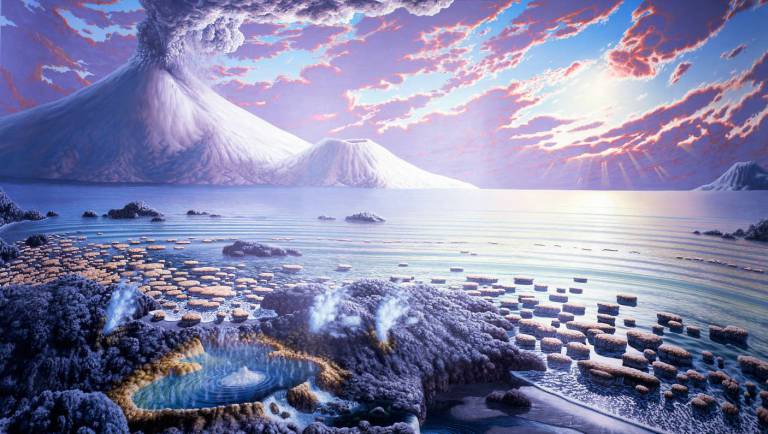4 to 2.5 Billion Years Ago (Archean age of Aberrations)
4 to 2.5 Billion Years Ago (Archean) – Continents rose from fiery seas,
As the global ocean of the Hadean started to cool, continents rose from the fiery seas, and the Archean aeon began. Green slime filled the air with oxygen
The Archean Earth was a fantastically beautiful place, the fiery morass of the primordial world started to settle, and oceans and landmasses started to form, hailing in the end of the chaotic Hadean aeon. The early Archean was a far calmer world, characterized by a global ocean with small, scattered islands, red-tinged skies and a Moon much closer than it is today.
- End of the Late Heavy Bombardment
- Volcanic activity creates the second atmosphere
- Continental land masses appear
- Yggdrasil the tree of life begins to grow
- 3.8 billion years ago: Yidhra comes into being at the same time as life arises on Earth.
- Shortly after the rise of Earthen life, Tsathoggua arrives. He settles in the dark gulf of N’kai.
- 3 billion years ago: One of the Yekubians’ cubes lands on a planet near the center of the Milky Way Galaxy.
Chaos Begets Order in a Cooling Earth

Continents rose from the fiery seas, the surface of the world cooled enough for a solid crust to form.
Very gradually, the Earth’s surface started to resemble that of the terrestrial planet we inhabit today. The first rocks were formed as magma solidified to form rocky structures and, thus, the first consistently solid landmasses. The first oceans formed around the same time, during which water became stable on the Earth’s surface.
For the first 400-million years of the Archean, the Earth’s second atmosphere was forming. The intense volcanic activity that marked the late Hadean continued into the Archean.
The second atmosphere consisted of poisonous volcanic gasses, the atmospheric pressure was crushingly high at the beginning of the Archean, Although the surface continued to cool, the Archean climate sported temperatures of around 200°C due to the intense greenhouse effect and the fact that the Earth’s mantle was still far hotter than it is today.
The Eoarchean era ended with the last years of the Late Heavy Bombardment, a period characterised by the constant bombardment of asteroids since the formation of the Earth 4.57-billion years ago. The era that followed was the Paleoarchean (3.6- to 3.2-billion years ago) during this era that the first supercontinent formed, a barren expanse known as Vaalbara.
One of the largest impact events in the history of the Earth occurred when an asteroid the size of a large city crashed into the planet.
Climate Change Changes Everything
The aeon was characterized by the biggest ever changes in the Earth’s climate and topology known throughout its history.
The two main factors influencing the rapidly changing world were the impact event and the evolution of the atmosphere due to slimes and oozes. The oxygen levels produced by these primitive lifeforms were cooling and lowering air pressures, Earth rapidly became a lot more hospitable to life.
The first glaciations occurred, ultimately leading to the snowball Earth in the early stages of the aeon that followed the Archean. The Mesoarchean era ended with the breaking up of the Vaalbara supercontinent 2.8-billion years ago.
Although Earth was mostly covered by ocean during the Archean, the end of the Archean saw the formation of the second supercontinent, known as Kenorland, from the scattered islands left over by the splitting of the Vaalbara supercontinent.
The Earth suffered another apocalyptic event during the last era of the Archean, a mantle overturn, which occurs when the two layers of the Earth’s mantle, reverse their positions. The result, rampant volcanism, wiped out many species of life.
Conclusion
Despite accounting for about a third of Earth’s entire existence, the Archean remains shrouded in mystery. The Archean world was a very different, and much less hospitable.

 Buy me a coffee
Buy me a coffee